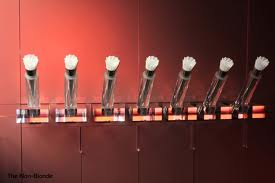No matter what industry you’re working in, if your business sells services, your ultimate goal is making your customers happy. At Virgin, we’ve always found that our front-line employees play a big role in that, with their cheerfulness, patience, resourcefulness, and dedication to listening to customers. But no matter how good they are, your staff will need you to set the stage for a great customer experience with good design — by providing a space that you, your employees and your customers love to be in.
A well-designed space immediately says that you care about the details and that you want to contribute something fun and meaningful to your customers’ lives — it will help them to relax and talk about what they’re looking for. We learned this accidentally, and early on — at our first storefront, in fact.
Our first Virgin Records store in London, which opened in 1971, was essentially a place for us to listen to music and meet new friends. It featured listening stations where customers could play records before buying them and beanbag chairs so that everyone could hang out. From that experience, my friends and I realized how important it was to create inviting, unique spaces that bring people together to discuss what they are passionate about: music, mobile apps, travel, even banking.
Yes, banking! When we launched Virgin Money in Britain, one of our newest businesses, we faced the challenge of making banking both fun and meaningful for customers. Our team’s answer was to offer people the opportunity to integrate banking into their everyday lives by eliminating lines and teller windows: The banks are designed to resemble living rooms, with both comfortable seating and work areas so that customers can use the space to meet friends, colleagues or our representatives. They can set up their laptops and use the space to do some work whenever they like, taking advantage of the free Wi-Fi, power outlets and newspapers we offer.
When you are designing your space, think about the problems that your customers are depending on you to solve. Many of our spaces address specific issues. For example, some people waiting in airports would prefer to spend their time productively, while others just want to relax, so we targeted both groups’ needs when we made our plans for Virgin America’s Terminal 2 at San Francisco International Airport.
For business travelers, we included Wi-Fi, power outlets and plentiful seating so that they can be as productive on the ground as they are in the air. For people more interested in recreation, we built a yoga room, a lounge with plentiful food and beverage choices, and shops featuring the best of San Francisco’s markets and chefs. We’ve heard from customers that T2 makes the airport an experience to look forward to, rather than just another stop along a tiring journey.
Remember, when it comes to design, it’s rare that one size fits all. Since the types of customers for your services may vary from location to location, you must be flexible. And as always, be sure to ask your front-line staff for ideas and get their thoughts on proposed designs. We have Virgin Active health clubs all over the world, and while they share common values, we encourage franchise owners to customize each club to fit the local community’s needs.
For example, many of our gyms in residential neighborhoods have terrific kid zones where children can be looked after while their parents work out. This allows multitasking moms and dads to get a break so that they can exercise — and relax afterward, too. Virgin Active Soweto, by contrast, serves many business commuters, so it operates a hair salon: After a good workout, people will look as good as they feel.
Even if you are putting everything you’ve got into just getting your startup off the ground, design is not an area where you should stint. The thought, effort and love you put into your business space shows your respect and consideration for your customers — the building blocks of great service. Relaxed, happy customers who know they are valued are more likely to engage with your staff, ask questions and find solutions tailored to their needs.
Have you walked into a store recently that made you feel comfortable, productive, healthy and happy? How did it make you feel about the company? What do such spaces all have in common? Entrepreneurs, tell me about your design challenge on Twitter, @richardbranson.
http://www.entrepreneur.com/article/225685















